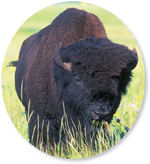27.1 Feeding and Digestion
 How do animals obtain food?
How do animals obtain food? How does digestion occur in animals?
How does digestion occur in animals? How are mouthparts adapted for different diets?
How are mouthparts adapted for different diets?
intracellular digestion
extracellular digestion
gastrovascular cavity
digestive tract
rumen
Outline Before you read, use the headings in this lesson to outline the ways animals obtain and digest food. As you read, add details to your outline.
THINK ABOUT IT From tiny insects that dine on our blood, to bison that feed on prairie grasses, to giant blue whales that feed on plankton, all animals are heterotrophs that obtain nutrients and energy from food. In fact, adaptations for different styles of feeding are a large part of what makes animals so interesting.

Obtaining Food
 How do animals obtain food?
How do animals obtain food?
As the old saying goes, you are what you eat. For animals, we can rephrase that as “how you look and act depends on what and how you eat.” The converse is also true: What and how you eat depends on how you look and act. To learn why that's true, we'll compare the various ways animals, such as those in Figure 27–1, obtain their food.
Filter Feeders Filter feeders strain their food from water.  Most filter feeders catch algae and small animals by using modified gills or other structures as nets that filter food items out of water. Many invertebrate filter feeders are small or colonial organisms, like worms and sponges, that spend their adult lives in a single spot. Many vertebrate filter feeders such as whale sharks and blue whales, on the other hand, are huge, and feed while swimming.
Most filter feeders catch algae and small animals by using modified gills or other structures as nets that filter food items out of water. Many invertebrate filter feeders are small or colonial organisms, like worms and sponges, that spend their adult lives in a single spot. Many vertebrate filter feeders such as whale sharks and blue whales, on the other hand, are huge, and feed while swimming.
Detritivores Detritus is made up of decaying bits of plant and animal material.  Detritivores feed on detritus, often obtaining extra nutrients from the bacteria, algae, and other microorganisms that grow on and around it. From earthworms on land to a wide range of worms and crustaceans in aquatic habitats, detritivores are essential components of many ecosystems.
Detritivores feed on detritus, often obtaining extra nutrients from the bacteria, algae, and other microorganisms that grow on and around it. From earthworms on land to a wide range of worms and crustaceans in aquatic habitats, detritivores are essential components of many ecosystems.
Carnivores  Carnivores eat other animals. Mammalian carnivores, such as wolves, use teeth, claws, and speed or stealthy hunting tactics to bring down prey. You probably don't often think about carnivorous invertebrates, but many would be terrifying if they were larger. Some cnidarians paralyze prey with poison-tipped darts, while some spiders immobilize their victims with venomous fangs.
Carnivores eat other animals. Mammalian carnivores, such as wolves, use teeth, claws, and speed or stealthy hunting tactics to bring down prey. You probably don't often think about carnivorous invertebrates, but many would be terrifying if they were larger. Some cnidarians paralyze prey with poison-tipped darts, while some spiders immobilize their victims with venomous fangs.

Table of Contents
- Formulas and Equations
- Applying Formulas and Equations
- Mean, Median, and Mode
- Estimation
- Using Measurements in Calculations
- Effects of Measurement Errors
- Accuracy
- Precision
- Comparing Accuracy and Precision
- Significant Figures
- Calculating With Significant Figures
- Scientific Notation
- Calculating With Scientific Notation
- Dimensional Analysis
- Applying Dimensional Analysis




